 W
WAn angler's loop, otherwise known as a perfection loop, is a type of knot which forms a fixed loop. Useful for fine or slippery line, it is one of the few loop knots which holds well in bungee cord. It is quite secure, but it jams badly and is not suitable if the knot will need to be untied.
 W
WThe artillery loop is a knot with a loop on the bight for non-critical purposes. The artillery loop must have the loop loaded or it will slip and contract easily. It is an inferior knot to the alpine butterfly knot, possibly dangerously so, in that it can be yanked out of shape and turn into a running knot or noose.
 W
WThe Bimini twist is a fishing knot used for offshore trolling and sportsfishing and the creation of double-line leaders. A Bimini twist creates a loop at the end of the line in which it is tied. The loop secured at the top with a long barrel of coiled line created by the tying process. A Bimini twist loop is stronger than the line itself. It is one of the rare knots that does not weaken the line in which it is tied. It is a simple method of doubling your fishing line in order to prevent chafing or to create the necessary loop in order to attach a wind-on leader without using strength in the mainline. For use in fishing applications, the old stand by is 20-30 initial twists in nylon monofilament and 60 or more initial-twists in Spectra-type braided line.
 W
WThe bowline is an ancient and simple knot used to form a fixed loop at the end of a rope. It has the virtues of being both easy to tie and untie; most notably, it is easy to untie after being subjected to a load. The bowline is sometimes referred to as King of the knots because of its importance. Along with the sheet bend and the clove hitch, the bowline is often considered one of the most essential knots.
 W
WThe Bowline on a bight is a knot which makes a pair of fixed-size loops in the middle of a rope. Its advantage is that it is reasonably easy to untie after being exposed to load. This knot can replace the figure-eight loop knot when tying into a climbing harness. It is one of the two tie-in knots that are being taught by the German Alpine Club (DAV), generally being considered secure.
 W
WIn fishing, a bumper knot can be used to secure soft or loose bait, including clusters of eggs, to a hook.
 W
WThe butterfly loop, also known as lineman's loop, butterfly knot, alpine butterfly knot and lineman's rider, is a knot used to form a fixed loop in the middle of a rope. Tied in the bight, it can be made in a rope without access to either of the ends; this is a distinct advantage when working with long climbing ropes. The butterfly loop is an excellent mid-line rigging knot; it handles multi-directional loading well and has a symmetrical shape that makes it easy to inspect. In a climbing context it is also useful for traverse lines, some anchors, shortening rope slings, and for isolating damaged sections of rope.
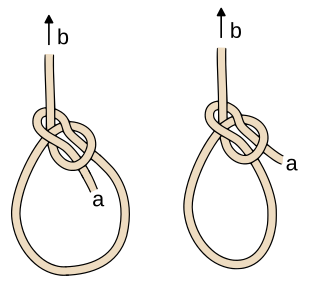 W
WThe cowboy bowline is a variation of the bowline loop knot.
 W
WThe diamond knot is a knot for forming a decorative loop on the end of a cord such as on a lanyard. A similar knot, also called the diamond knot, is a multistrand stopper knot, that is similar in appearance. To avoid confusion, it is advisable to call this knot the knife lanyard knot. This knot is a four strand diamond knot implemented in two strands. The knife lanyard knot is "tied alike" the Chinese button knot, "but they are worked differently."The sailor's knife lanyard knot, also called marling-spike lanyard knot, single-strand diamond knot, two-strand diamond knot, and Bosun's whistle knot.
 W
WThe directional figure eight is a loop knot. It is a knot that can be made on the bight. The loop must only be loaded in the correct direction or the knot may fail. It is useful on a hauling line to create loops that can be used as handholds. It also provides a place to attach a Z-Drag to the line when prusiks are unavailable.
 W
WA double bowline is a type of loop knot. Instead of the single turn of the regular bowline, the double bowline uses a round turn. This forms a more secure loop than a standard bowline.
 W
WA double figure-eight loop, is a type of knot that forms two parallel loops, and resembles the figure-eight loop.
 W
WThe dropper loop is a type of loop knot often used on multi-hook fishing lines. It can be created in the middle of a long line and forms a loop which is off to the side of the line.
 W
WThe Eskimo bowline, Cossack knot, reverse bowline, or 'anti-bowline' is in a class of knots known as 'eye knots' or 'loop knots'. The eye is formed in the end of the rope to permit attachments/connections. It is quite common in Russia and is often used instead of the bowline. In the simple bowline, the collar component forms around the 'standing part'. In contrast, the collar component of an Eskimo bowline forms around the outgoing eye-leg.
 W
WThe farmer's loop is a knot which forms a fixed loop. As a midline loop knot made with a bight, it is related to several other similar knots, including the alpine butterfly knot and artillery loop.
 W
WThe fiador knot is a decorative, symmetrical knot used in equine applications to create items such as rope halters, hobbles, and components of the fiador on some hackamore designs. As traditionally described, it is a four strand diamond knot in which six of the eight ends loop back into the knot, thus allowing it to be tied with a single line. While a specific knot is discussed in this article, the fiador knot has also been treated as an entire class of multi-strand knots similarly made with a single line.
 W
WFigure-eight loop is a type of knot created by a loop on the bight. It is used in climbing and caving where rope strains are light to moderate and for decorative purposes.The Flemish loop or figure-eight loop is perhaps stronger than the loop knot. Neither of these knots is used at sea, as they are hard to untie. In hooking a tackle to any of the loops, if the loop is long enough it is better to arrange the rope as a cat's paw.
 W
WThe figure-of-nine loop is a type of knot to form a fixed loop in a rope. Tied in the bight, it is made similarly to a figure-of-eight loop but with an extra half-turn before finishing the knot.
 W
WA fireman's chair knot is a knot tied in the bight forming two adjustable, lockable loops. The knot consists of a handcuff knot finished with a locking half hitch around each loop. The loops remain adjustable until the half hitches are tightened.
 W
WSome consider that a French bowline is the same as a Portuguese bowline, i.e. a bowline with two loops that can be used as a bosun's chair.
 W
WFriendship knot loop is a knot to tie a secure and stable loop at the end of a rope.
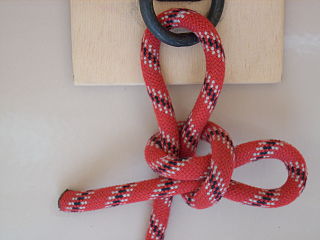 W
WThe halter hitch is a type of knot used to connect a rope to an object. As the name implies, an animal's lead rope, attached to its halter, may be tied to a post or hitching rail with this knot. The benefit of the halter hitch is that it can be easily released by pulling on one end of the rope, even if it is under tension. Some sources show the knot being finished with the free end running through the slipped loop to prevent it from working loose or being untied by a clever animal, still allowing easy but not instant untying.
 W
WA handcuff knot is a knot tied in the bight having two adjustable loops in opposing directions, able to be tightened around hands or feet. The knot itself does not possess any inherent locking action, and thus is not as easy to use for such purposes as the name might suggest.
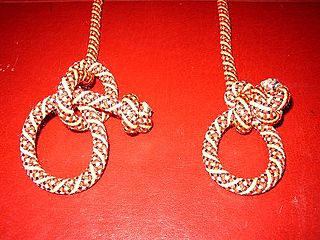 W
WA honda knot is the loop knot commonly used in a lasso. Its round shape, especially when tied in stiff rope, helps it slide freely along the rope it is tied around. To tie, first place an overhand knot in the end of the rope. Then tie a second overhand knot, pass the running end of the rope through it, and tighten.
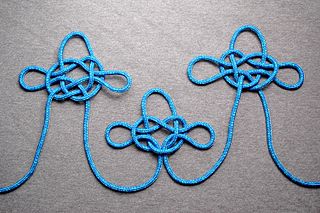 W
WThe jury mast knot is traditionally used for jury rigging a temporary mast on a sailboat or ship after the original one has been lost. The knot is placed at the top of a new mast with the mast projecting through the center of the knot. The loops of the knot are then used as anchor points for makeshift stays and shrouds. Usually small blocks of wood are affixed to, or a groove cut in, the new mast to prevent the knot from sliding downwards.
 W
WThe Kalmyk Loop is a fixed loop still largely unused in the West, but common in Russia and often used instead of the bowline.
 W
WKarash double loop is a common name for a knot forming two loops. This knot has been a known variant of the Bowline on a bight per the International Guild of Knot Tyers, referred to as bowline twist or twisted collar bowline on a bight. The knot is also referred to as nœud de fusion in French references and sometimes called Fusion knot in English.
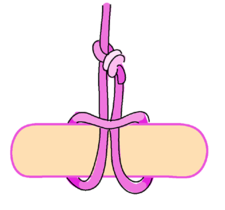 W
WThe bale sling hitch is a knot which traditionally uses a continuous loop of strap to form a cow hitch around an object in order to hoist or lower it. In practice, a similar arrangement can also be formed using a fixed loop at the end of a rope. This loop could be formed at the end of a line with a knot, such as the bowline, or a large eye splice.
 W
WA noose is a loop at the end of a rope in which the knot tightens under load and can be loosened without untying the knot. The knot can be used to secure a rope to a post, pole, or animal but only where the end is in a position that the loop can be passed over.
 W
WThe overhand loop is a simple knot which forms a fixed loop in a rope. Made by tying an overhand knot in the bight, it can be tied anywhere along a rope. The knot can be used for attaching clips, hooks, other rope, etc., but has the disadvantage that it is likely to jam tight when the rope has been pulled and the knot may need to be cut off. It also has some uses in kite-flying, though other knots may be better. It is commonly disapproved by the Boy Scouts because of its tendency to be misused as an alternative to the bowline.
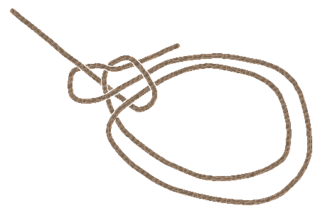 W
WThe Portuguese bowline is a variant of the bowline with two loops. The two loops are adjustable in size. Rope can be pulled from one loop into the other one even after tightening. It can be used as a makeshift Bosun's chair.
 W
WThe rigid double splayed loop in the bight is a knot that contains two parallel loops. Clifford Ashley wrote that it is "one of the firmest of the Double Loops since the two loops do not directly communicate with each other".. It is a variation of the alpine butterfly knot.
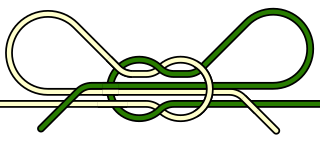 W
WThe shoelace knot, or bow knot, is commonly used for tying shoelaces and bow ties.
 W
WThe slippery eight loop is an adjustable loop knot discovered by Dave Poston in 2002.
 W
WA span loop is a non-jamming loop that can be tied away from the ends of the rope.
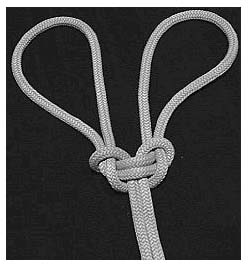 W
WThe Spanish bowline is a double loop knot that can be used to lift a person. For a conscious person, each loop is placed around a leg and the person holds onto the standing part of the rope. This knot can serve as a makeshift Bosun's chair. For an unconscious person one loop is placed around the arm pits and the second loop is placed around the knees.
 W
WThe trident loop is a fixed loop knot which can jam when heavily loaded. It was proposed as a replacement for the figure-of-eight loop for use in climbing by Robert M. Wolfe, MD, who developed it as a loop form of Ashley's bend. While some tests indicate its strength lies somewhere between the weaker Bowline and stronger figure-of-eight loop, the trident loop shows exceptional resistance to slipping in shock-loading tests.
 W
WThe triple bowline knot is a variation of the bowline knot. The knot can be applied to emergency situations, such as mountain rescue.
 W
WThe water bowline is a type of knot designed for use in wet conditions where other knots may slip or jam.
 W
WA Yosemite bowline is a loop knot often perceived as having better security than a bowline. If the knot is not dressed correctly, it can potentially collapse into a noose, however testing reveals this alternative configuration to be strong and safe as a climbing tie-in.
 W
WA zeppelin eye knot, is a secure, jam resistant fixed size loop knot based on the zeppelin bend. It is one of the few eye knots suitable for bungee. It is also special in its ease of untying.
 W
W W
W W
W W
W W
W W
W W
W W
W W
W W
W W
W